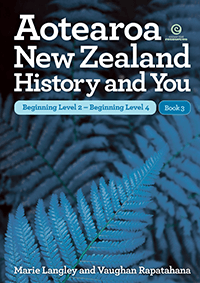
Aotearoa New Zealand History and You - Bk 3
Beginning Level 2 - Beginning Level 4
Purchase Aotearoa New Zealand History and You - Book 3 to help tamariki to understand Aotearoa history and how it has shaped our present lives.
The activities in Book 3 of the Aotearoa New Zealand History and You series are provided at two levels, allowing you to create New Zealand history lesson plans suitable for the learning level of your class. In line with the Aotearoa New Zealand's histories curriculum, Te Takanga o Te Wa, these encourage tamariki to engage with the complete human history of Aotearoa.
The activities for Beginning Level 2 to Beginning Level 3 pick up from where the Book 2 activities left off, in the 19th century following the arrival of Pakeha in Aotearoa New Zealand. The activities for Level 3 to Beginning Level 4 explore topics from the arrival of the first peoples in Aotearoa from the Pacific Islands and their evolving history as tangata whenua. The journey continues to the early days of contact with Europeans through to the current era.
|
NZD incl GST
|
Add to cart | |
| or more | each |





